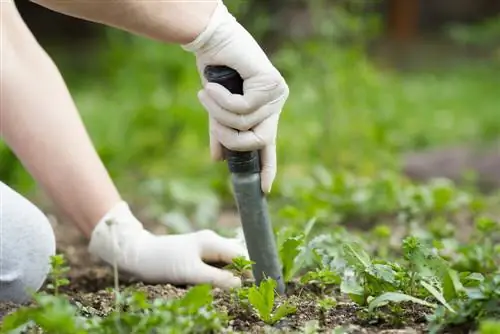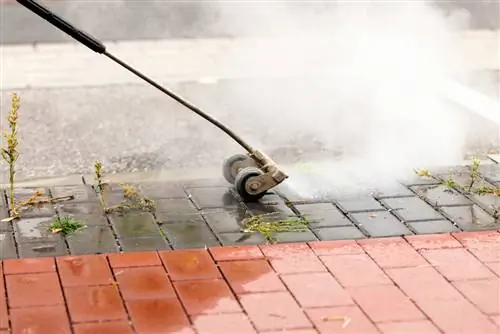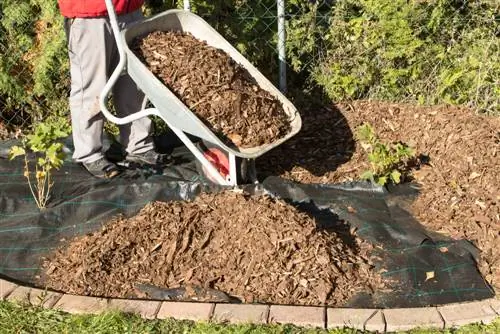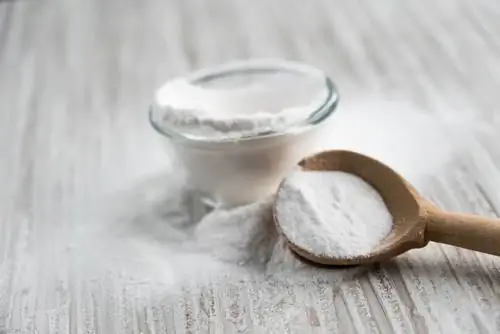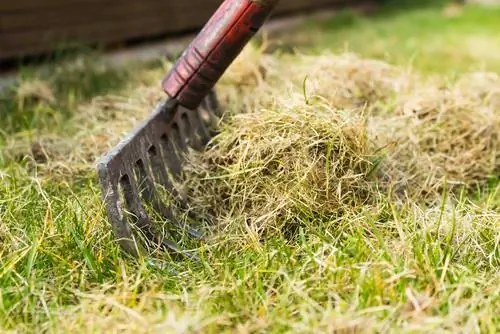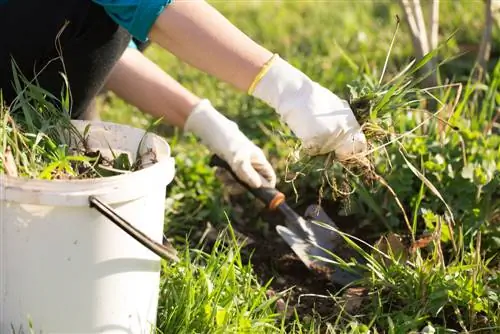- Author admin [email protected].
- Public 2023-12-16 16:46.
- Last modified 2025-01-23 11:21.
Weeds in the lawn, flower bed or vegetable garden are among the uninvited guests that many gardeners want to get rid of as quickly as possible. But what really helps against dandelions or groundweed and at the same time protects the delicate ecological balance? With our tips you can get rid of the unwanted plants, even without chemicals.

How to kill weeds without chemicals?
To destroy weeds effectively and in an environmentally friendly way, remove them regularly, weed them properly, mulch the soil, plant vigorous ground cover, use boiling water and use the weeds sensibly, for example as fertilizer or in the kitchen.
Tip 1: Don’t leave weeds standing for too long
It is important to remove wild herbs as quickly and regularly as possible, even before they set seeds. If the wind already carries them away, it is only a matter of time before the seeds sprout again somewhere else.
If you have little time, you should walk through the garden briefly every day and remove the flower heads directly. In this way, the newly germinating weeds can be greatly reduced.
Tip 2: Weed properly
Depending on the type of wild plant, other destruction methods are recommended. It is best to dig varieties such as dandelions or thistles deeply because they have roots that extend far into the ground. If you were to simply tear off the greenery, new plants would develop from these within a very short time.
Weeding groundweed or couch grass, which have a widely branched root system, is made easier with a shuffle (€17.00 on Amazon). After loosening the soil, carefully pick out even the smallest root residues.
If the soil is soft after rainfall, weeding freshly germinated wild herbs is easier. They can then simply be pulled out of the ground using their roots.
Tip 3: Mulching
If you want to curb weed growth in the long term, you should use this old technique. Mulching involves covering the soil with organic material. Suitable for this:
- green cuttings
- Leaves
- small chopped branches
- Bark mulch
- Straw
- Compost
- Sawdust
Apply the material about three to four centimeters thick. Since most wild herbs germinate in the light, the plants cannot develop under the protective cover. At the same time, mulch provides valuable food for soil organisms and thus ensures long-term improvement in the soil.
Tip 4: Plant vigorous ground cover
Ground-cover plants against weeds, such as bergenia, blue periwinkle or blood cranesbill, have the same effect as mulch. They spread very quickly and deprive unwanted plants of light so that the weed seeds do not sprout.
Tip 5: Boiling water instead of s alt and vinegar
Vinegar and s alt are still recommended as weed killers. However, you should stay away from these home remedies because their use for this purpose is prohibited by law.
An effective way to combat weeds is water that is applied very hot or at high pressure. It destroys the cell structure of plants and causes them to die. However, you should not use boiling water in the bed as the neighboring plants will also be damaged.
An alternative are flame burners, which simply burn off the weeds. However, the roots are often not reached by the flame, so dandelions and other plants with stable roots can sprout again after this treatment. We recommend reworking with a joint scraper.
Tip 6: Use weeds sensibly
Effective liquid fertilizers and plant protection products can be made from nettle, groundweed and other weeds with little effort. For this purpose, place the mechanically weeded and chopped wild herbs, which should not bear any seeds, in a bucket and fill it with water.
Place the container in a sunny spot in the garden and stir once a day. A handful of stone powder or valerian flower extract sprinkled on the surface reduces unpleasant odors. If the manure has taken on a dark color, it is ready for use.
What also helps: simply eat the wild herbs
Even if you don't want to start a vegetable garden: dandelions, groundweed, chickweed and daisies are extremely tasty and rich in vitamins and minerals. It's a shame to simply tear them out and put them in the organic waste. Below are some types of edible weeds:
Giersch
This tastes pleasantly spicy and is reminiscent of parsley. For this reason it was even cultivated on a large scale in the Middle Ages. Young leaves taste good raw in salads or as pesto. The older leaves enrich stews and casseroles.
Dandelions
You can enjoy cut dandelions raw as a salad or, together with weeded nettles, make a tasty soup from the wild herb. The bright yellow flowers are not only pretty, but also an extremely aromatic decoration for summer salads.
Stinging Nettle
The nettle is a very valuable medicinal herb and a small nutrient bomb. The leaves contain an active ingredient that inhibits the growth of bacteria and more vitamin C than citrus fruits. Nettle leaves can be prepared like spinach or eaten raw in a salad.
Tip
You should avoid chemical weed killers if possible. These can not only undesirably damage ornamental plants and animals as well as wild herbs, but they also only make the work a little easier. Substances such as pelargonic acid destroy the cells of plants and cause them to die above ground. The roots, however, remain standing. So you can't avoid removing the dead greenery from the bed and laboriously digging out the weed roots.

